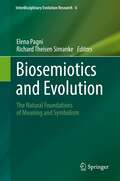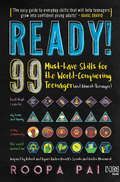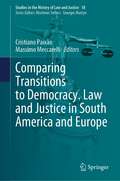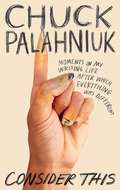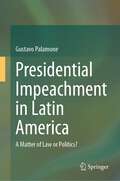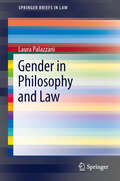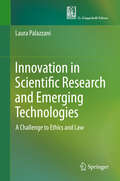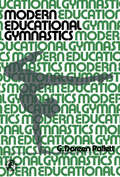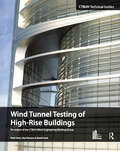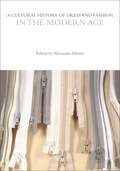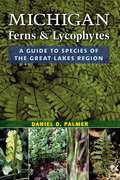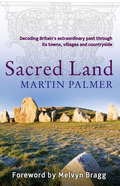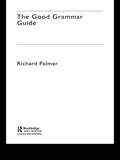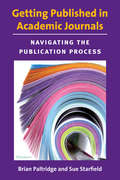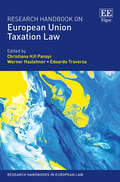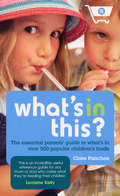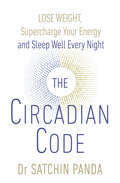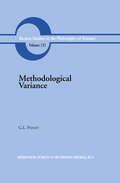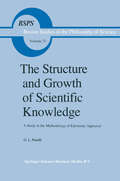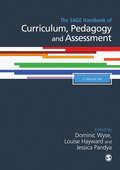- Table View
- List View
Biosemiotics and Evolution: The Natural Foundations of Meaning and Symbolism (Interdisciplinary Evolution Research #6)
by Elena Pagni Richard Theisen SimankeThis book reviews the evolution of Biosemiotics and gives an outlook on the future of this interdisciplinary new discipline. In this volume, the foundations of symbolism are transformed into a phenomenological, technological, philosophical and psychological discussion enriching the readers’ knowledge of these foundations. It offers the opportunity to rethink the impact that evolution theory and the confirmations about evolution as a historical and natural fact, has had and continues to have today. The book is divided into three parts:Part I Life, Meaning, and InformationPart II Semiosis and EvolutionPart III Physics, medicine, and bioenergetics It starts by laying out a general historical, philosophical, and scientific framework for the collection of studies that will follow. In the following some of the main reference models of evolutionary theories are revisited: Extended Synthesis, Formal Darwinism and Biosemiotics. The authors shed new light on how to rethink the processes underlying the origins and evolution of knowledge, the boundary between teleonomic and teleological paradigms of evolution and their possible integration, the relationship between linguistics and biological sciences, especially with reference to the concept of causality, biological information and the mechanisms of its transmission, the difference between physical and biosemiotic intentionality, as well as an examination of the results offered or deriving from the application in the economics and the engineering of design, of biosemiotic models for the transmission of culture, digitalization and proto-design. This volume is of fundamental scientific and philosophical interest, and seen as a possibility for a dialogue based on theoretical and methodological pluralism. The international nature of the publication, with contributions from all over the world, will allow a further development of academic relations, at the service of the international scientific and humanistic heritage.
Ready!: 99 MUST-HAVE SKILLS FOR THE WORLD-CONQUERING TEENAGER (AND ALMOST-TEENAGER)
by Roopa PaiAll you need to do is crack the 99 fundamental – and fun – life skills outlined in this book, and win all the 24 Merit Badges and 4 Shields inside. The best part? You compete only with yourself! By the time you’re through, you will own skills as diverse as growing your own veggies in a Square Foot Garden to petitioning for change in your community, making a cup of chai to setting up a sickroom, launching your own business to telling time by the position of the moon! Written by bestselling author Roopa Pai in her unmatchable style, this book packs in 99 simple but vital techniques that will enable you to be a hero to yourself – and a role model to your peers. Are. You. READY!?
Comparing Transitions to Democracy. Law and Justice in South America and Europe (Studies in the History of Law and Justice #18)
by Cristiano Paixão Massimo MeccarelliThis present book examines some of the key features of the interplay between legal history, authoritarian rule and political transitions in Brazil and other countries from the end of 20th Century until today. This book casts light on these aspects of the role of law and legal actors/institutions. In the context of transition from authoritarian rule to democratic state, Brazil has produced a significant literature on the challenges and shortcomings of the transition, but little attention has been given to the role of law and legal actors/institutions. Different approaches focus on the legal mechanisms, discourses and practices used by the military regime and by the players involved in the political transition process in Brazil. A comparative perspective that takes into account different political transitions – and their legal consequences – in Europe and Latin America complements the analysis. Part 1 (4 essays) discusses some of the central issues of political transition and legal history in contemporary Brazil, focusing on the time of the transition (and its effects on transitional justice) with different perspectives, from racial and gender issues to constitutional reform and police repression. Part 2 (3 essays) brings the comparative studies on South American experiences. Part 3 (4 essays) analyses different cases of transition to democracy in Chile, Portugal, Spain and Italy. Part 4 (3 essays) proposes a historiographical and methodological approach, considering the politics of time involved in the interplay between political transitions and legal history.
Consider This: Moments in My Writing Life after Which Everything Was Different
by Chuck PalahniukRenowned, bestselling novelist Chuck Palahniuk takes us behind the scenes of the writing life, with postcards from decades on the road and incredible examination of the power of fiction and the art of storytelling.In this spellbinding blend of memoir and insight, bestselling author Chuck Palahniuk shares stories and generous advice on what makes writing powerful and what makes for powerful writing.With advice grounded in years of careful study and a keenly observed life, Palahniuk combines practical advice and concrete examples from beloved classics, his own books, and a "kitchen-table MFA" culled from an evolving circle of beloved authors and artists, with anecdotes, postcards from the road, and much more.Clear-eyed, sensitive, illuminating, and knowledgeable, Consider This is Palahniuk's love letter to stories and storytellers, booksellers and books themselves. Consider it a classic in the making.
Presidential Impeachment in Latin America: A Matter of Law or Politics?
by Gustavo PalamoneThis book pursues a comparative and interdisciplinary approach to assess presidential impeachments in Latin America. Mixing methodologies from legal studies and political science, it provides a novel and comprehensive assessment of some of the most controversial questions regarding the constitutional function of impeachment and its place in the theory of government.Presidential impeachments have become frequent in Latin America, yet they are still largely misunderstood by legal practitioners and the general public. As such, impeachments frequently provide for heated and polarizing debates. The misunderstandings stem from skewed expectations arising from different theories of government, legal interpretation, and presidential impeachment. The empirical evidence and arguments presented here will help to find common ground on these topics and pacify some latent tensions in society and academia. In addition, the book’s case studies cover cases that have been rarely or incompletely addressed in the literature. Some cover events so recent that they have never been analyzed elsewhere.The book proposes reconsidering certain assumptions made about systems of government, which are based on skewed expectations of impeachments. It also draws on new evidence to re-examine existing impeachment theories and develop new ones. By doing so, it offers valuable insights that may guide lawmakers to redesign their own systems, optimizing them to achieve certain goals. It will also acquaint legal practitioners with the strategies of prosecution, defense, and decision-making in connection with impeachments.
Gender in Philosophy and Law (SpringerBriefs in Law)
by Laura PalazzaniThis book is an introductory systematic framework in the complex and interdisciplinary sex/gender debate, focusing on philosophy of law.The volume analyses the different theories that have dealt with the gender category, highlighting the conceptual premises and the arguments of the most influential theories in the debate, which have had repercussions on the field of the ethical and juridical debate (with reference to intersexuality, transsexualism, transgender, homosexuality). The aim is to offer a sort of conceptual orientation in the complexity of the debate, in an effort to identify the various aspects and development processes of the theories, so as to highlight the conceptual elements of the theorisations to grasp the problem areas within them. It is therefore an overall synthetic and also explicative analysis, but not only explicative: the aim is to outline the arguments supporting the different theories and the counter-arguments too, for the purpose of proposing categories to weigh up the elements and to take one’s own critical stance, with a methodological style that is neither descriptive nor prescriptive, but critical.
Innovation in Scientific Research and Emerging Technologies: A Challenge to Ethics and Law
by Laura PalazzaniThis book discusses the ethical and legal challenges related to innovations, with reference to both scientific research and emerging technologies. It analyzes scientific research with specific reference to experimentation, with a focus on vulnerable people (minors, women, people in developing countries), compassionate care, biobanks and ethical committees. In the context of emerging technologies, it examines the ethical and legal aspects of neuroscience, genomics, ICT, big data, biometrics, converging technologies, enhancement and robotics. The book provides conceptual tools and categories to help readers understand and acquire a critical awareness of the current debates in the field.
What Your Doctor May Not Tell You About(TM) HPV and Abnormal Pap Smears: Get the Facts on this Dangerous Virus-Protect your Health and Your Life!
by Joel Palefsky Jody HandleyHuman Papilloma Virus - HPV - is a sexually transmitted disease that is known as 'the silent killer' because its symptoms are so ambiguous most people don't know they have it. This book will raise awareness of this disease, as well as other abnormal smear tests, and provide much needed information and support.
Modern Educational Gymnastics
by G. Doreen PallettModern Educational Gymnastics provides a guide in gymnastics based on Rudolf Laban’s analysis of movement. This book sets out a discipline and standard, demanding perseverance, grit, and determination in individual ways of moving that provides every individual with an opportunity to achieve not only possibilities in movement and physical prowess, but ideas as well. The topics covered include weight transference; fundamental body action of bending, stretching, turning, and twisting; awareness of the body; way or how a person moves; time, space, and flow factors; use of space; apparatus work; and working with other people. Brief discussions on forming a lesson, achieving good poise, and use of observation to the teacher and students are also deliberated in this text. This publication is intended for gymnastics teachers, but is also useful to students or individuals hoping to acquire knowledge on the fundamentals and basic principles of gymnastics.
Who's Who in Modern History
by Alan PalmerWho's Who in Modern History is a unique reference book which examines those individuals who have shaped the political world since 1860. Coverage is truly global, including the most important figures in Europe, Asia, North America, Latin America, Africa and Australasia.It provides:* an easy-to-use A-Z layout* authoritative, detailed biographies of the most important figures since 1860, from Clemenceau and Chief Buthelezi to King Fahd and Benazir Bhutto* bibliographical references for each entry, to aid further research* extensive cross-referencing* an essential guide for students, researchers and the general reader alike.
Who's Who in Modern History
by Alan PalmerWho's Who in Modern History is a unique reference book which examines those individuals who have shaped the political world since 1860. Coverage is truly global, including the most important figures in Europe, Asia, North America, Latin America, Africa and Australasia.It provides:* an easy-to-use A-Z layout* authoritative, detailed biographies of the most important figures since 1860, from Clemenceau and Chief Buthelezi to King Fahd and Benazir Bhutto* bibliographical references for each entry, to aid further research* extensive cross-referencing* an essential guide for students, researchers and the general reader alike.
A Cultural History of Dress and Fashion in the Modern Age (The Cultural Histories Series)
by Alexandra PalmerOver the last century there has been a complete transformation of the fashion system. The unitary top-down fashion cycle has been replaced by the pulsations of multiple and simultaneous styles, while the speed of global production and circulation has become ever faster and more complex. Running in tandem, the development of artificial fibres has revolutionized the composition of clothing, and the increased focus on youth, sexuality, and the body has radically changed its design. From the 1920s flapper dress to debates over the burkini, fashion has continued to be deeply involved in society's larger issues.Drawing on a wealth of visual, textual and object sources and illustrated with 100 images, A Cultural History of Dress and Fashion in the Modern Age presents essays on textiles, production and distribution, the body, belief, gender and sexuality, status, ethnicity, and visual and literary representations to illustrate the diversity and cultural significance of dress and fashion in the period.
A Cultural History of Dress and Fashion in the Modern Age (The Cultural Histories Series)
by Alexandra PalmerOver the last century there has been a complete transformation of the fashion system. The unitary top-down fashion cycle has been replaced by the pulsations of multiple and simultaneous styles, while the speed of global production and circulation has become ever faster and more complex. Running in tandem, the development of artificial fibres has revolutionized the composition of clothing, and the increased focus on youth, sexuality, and the body has radically changed its design. From the 1920s flapper dress to debates over the burkini, fashion has continued to be deeply involved in society's larger issues.Drawing on a wealth of visual, textual and object sources and illustrated with 100 images, A Cultural History of Dress and Fashion in the Modern Age presents essays on textiles, production and distribution, the body, belief, gender and sexuality, status, ethnicity, and visual and literary representations to illustrate the diversity and cultural significance of dress and fashion in the period.
Michigan Ferns and Lycophytes: A Guide to Species of the Great Lakes Region
by Daniel D PalmerMichigan’s ferns and lycophytes are among the state’s most fascinating plants. The species in these groups exhibit incredibly diverse life cycles and an amazing array of morphology. Some species such as the Bracken fern are widespread and aggressive, dominating forest understories throughout much of northern Michigan, while other species are exceedingly rare and adapted to life solely in harsh niche habitats where little else can grow. Unlike the well-studied flowering plants and gymnosperms, Michigan’s ferns and lycophytes have long lacked a reliable, up-to-date guidebook, and this book fills that gap. Covering all 120 taxa found in the state, it features detailed keys, species descriptions, and range maps alongside precise illustrations. Readers learn about the etymology of species’ common and scientific names as well as interesting facts about their historic uses by humans and place within the Michigan ecosystem. The book also provides information on the challenging taxonomy of many ferns and lycophytes, with special attention given to the species likely to hybridize and those prone to misidentification. This is a must-have reference for anyone who wishes to learn about these important components of the Great Lakes flora.
Sacred Land: Decoding Britain's extraordinary past through its towns, villages and countryside
by Martin PalmerSACRED LAND will enable you to discover the hidden secrets and meaning of the landscape around you, town or country, modern or old, wherever you live in Britain. There has been a dramatic growth in interest in our own history, buildings, landscape, sacred places, beliefs and culture over the last few years and this book will equip you with the tools to unlock the meaning, stories and history that are literally embedded in our landscape. It takes us from street names to churches; from hill forts to burial mounds; from the way a road bends to the shapes of fields in order to understand better the land that lies beneath our feet. In the literal shape of our countryside can be detected the eddies of time, politics, belief, warfare, passion and the durability of the human existence.SACRED LAND is a fascinating, accessible read and the perfect reference guide to have in your home or in your car. It will be of interest to everyone who loves history, sacred places and sacred history, and those who like to explore their ancestry and roots.
The Good Grammar Guide (Routledge Study Guides Ser.)
by Richard PalmerDoes grammar bother you? Does it first inspire boredom, then fear? Since the virtual removal of formal grammar teaching from our schools' standard curriculum forty years ago, such negative responses have increasingly characterised students and professionals alike. As this lively and user-friendly book sets out to prove, that is both unfortunate and unnecessary. Not only is grammar an enabling servant rather than a tyrannical set of absolute rules: it can also be fun. This light-hearted guide offers extensive coverage of Parts of Speech, Syntax, Inflection and Punctuation, along with a detailed look at common errors and misconceptions. Regular exercises are included, as is a baleful survey of Political Correct usage, whose desire to sanitize and control the way we speak is injurious to grammar, language itself and indeed the way we live now. The aim throughout this book is to reassure and entertain as well as instruct. This handy volume puts an amusing light on grammar, and as such it is guaranteed to banish boredom and fear. The Good Grammar Guide can also be read as a companion to one of Richard Palmer's other publications, Write in Style 2nd Edition, also published in Routledge's Study Guides series.
The Good Grammar Guide
by Richard PalmerDoes grammar bother you? Does it first inspire boredom, then fear? Since the virtual removal of formal grammar teaching from our schools' standard curriculum forty years ago, such negative responses have increasingly characterised students and professionals alike. As this lively and user-friendly book sets out to prove, that is both unfortunate and unnecessary. Not only is grammar an enabling servant rather than a tyrannical set of absolute rules: it can also be fun. This light-hearted guide offers extensive coverage of Parts of Speech, Syntax, Inflection and Punctuation, along with a detailed look at common errors and misconceptions. Regular exercises are included, as is a baleful survey of Political Correct usage, whose desire to sanitize and control the way we speak is injurious to grammar, language itself and indeed the way we live now. The aim throughout this book is to reassure and entertain as well as instruct. This handy volume puts an amusing light on grammar, and as such it is guaranteed to banish boredom and fear. The Good Grammar Guide can also be read as a companion to one of Richard Palmer's other publications, Write in Style 2nd Edition, also published in Routledge's Study Guides series.
Getting Published in Academic Journals: Navigating the Publication Process
by Brian Richard Paltridge Sue StarfieldThe pressure on graduate students and new PhDs to publish their work continues to grow with writing and publishing considered an important measure of career success within the academy. There is, however, more to the process of getting published than those who are new to the process initially realize. The aim of this guide is to clarify the process and offer advice. Getting Published in Academic Journals is written for graduate students and newly graduated PhDs who want to publish their research in peer-reviewed academic journals. Getting Published in Academic Journals draws on the experiences of the authors’ as editors of peer-reviewed journals, as teachers of writing-for-publication courses and workshops, as researchers of the scholarly publication process, as reviewers of hundreds of articles, and as published authors. The book is written to be used in courses and workshops on publishing, as a supplement to the books in the revised and updated English in Today’s Research World (Swales & Feak) series, and as a stand-alone guide for academic writers working by themselves.
Research Handbook on European Union Taxation Law (Research Handbooks in European Law series)
by Christiana Hji Panayi Werner Haslehner Edoardo TraversaOffering a comprehensive exploration of EU taxation law, this engaging Research Handbook investigates the relevant legal principles in the context of both direct and indirect taxation. The important issues and debates arising from these general principles are expertly unpicked, with leading scholars examining the status quo as well as setting out a clear agenda for future research. This multidisciplinary book provides an insight into the taxation of individuals, businesses, passive investment and the non-profit sector. It reviews the harmonisation debate in the areas of corporate taxation and Value Added Tax, and also analyses the current developments as to energy and environmental taxation. Tax competition, state aid and the impact of the international polemic against aggressive tax planning are explored, as are the more procedural but equally important topics dealing with cooperation between tax authorities, exchange of information, taxpayer rights and dispute resolution. The final part of this book examines the external dimension to EU tax law – not only as far as the fundamental freedoms are concerned but also in the context of trade agreements and association agreements. An essential resource for students and scholars of EU taxation law, this Handbook will also appeal to practitioners and government officials working in taxation across the EU and beyond.
What's In This?: The essential parents' guide to what's in over 500 popular children's foods
by Clare PanchooFor mums and dads in a rush, buying convenience foods is a reality but ingredient labels often read like a complicated science experiment. Somehow parents are meant to decode the complex terminology, additives and E numbers to provide healthy food. So this book is for today's concerned parents who want to know what really goes into the food that they feed their children. Revealing exactly what can be found in over 500 of the top foods that target children, as well as any side effects that the ingredients have been found to cause, this colourful, easy to use A-Z reference guide demystifies the complex jargon for parents, from the definition of ascorbic acid to what is actually in brown sugar.
The Circadian Code: Lose weight, supercharge your energy and sleep well every night
by Dr Satchidananda PandaChange your daily routine, transform your health.Circadian rhythms are biological processes or clocks that exist in each one of our cells. Programmed to turn genes on or off at different times of the day or night, they influence every aspect of our health from weight and energy levels through to resistance to disease and infection, and how well we sleep.Now, in The Circadian Code, this new science is revealed, showing that the timings of our day (when we eat, sleep, exercise, work) are more crucial than we ever thought before. And that, most importantly, if your daily schedule is out of sync with your circadian rhythms, you can fix it!Whether you are a shift worker, a frustrated dieter, someone suffering from sleep problems or chronic illness, whatever your health concern, The Circadian Code is the key to unlocking your health.
Methodological Variance: Essays in Epistemological Ontology and the Methodology of Science (Boston Studies in the Philosophy and History of Science #131)
by G.L. PanditFor a philosopher with an abiding interest in the nature of objective knowledge systems in science, what could be more important than trying to think in terms of those very subjects of such knowledge to which men like Galileo, Newton, Max Planck, Einstein and others devoted their entire lifetimes? In certain respects, these systems and their structures may not be beyond the grasp of a linguistic conception of science, and scientific change, which men of science and philosophy have advocated in various forms in recent times. But certainly it is wrong-headed to think that one's conception of science can be based on an identification of its theories with languages in which they may be, my own alternatively, framed. There may be more than one place in book (1983: 87) where they may seem to get confused with each other, quite against my original intentiens. The distinction between the objec tive knowledge systems in science and the dynamic frameworks of the languages of the special individual sciences, in which their growth can be embedded in significant ways, assumes here, therefore, much impor tance. It must be recognized that the problems concerning scientific change, which these systems undergo, are not just problems concerning language change.
The Structure and Growth of Scientific Knowledge: A Study in the Methodology of Epistemic Appraisal (Boston Studies in the Philosophy and History of Science #73)
by G.L. PanditProfessor Pandit, working among the admirable group of philosophers at the University of Delhi, has written a fundamental criticism and a constructive re-interpretation of all that has been preserved as serious epistemological and methodological reflections on the sciences in modern Western philosoph- from the times of Galileo, Newton, Descartes and Leibniz to those of Russell and Wittgenstein, Carnap and Popper, and, we need hardly add, onward to the troubling relativisms and reconstructions of historical epistemologies in the works of Hanson, Kuhn, Lakatos and Feyerabend. His themes are intrigu ing, set forth as they are with masterly case studies of physics and the life sciences, and within an original conceptual framework for philosophical analysis of the processes, functions, and structures of scientific knowing. Pandit's contributions deserve thoughtful examination. For our part, we wish to point to some among them: (1) an interactive articulation of subjective and objective factors of both problems and theories in the course of scientific development; (2) a striking contrast between the explanatory power of a scientific theory and its 'resolving power', i. e.
The SAGE Handbook of Curriculum, Pedagogy and Assessment
by Ms Jessica Pandya Professor Dominic Wyse Ms Louise HaywardThe research and debates surrounding curriculum, pedagogy and assessment are ever-growing and are of constant importance around the globe. With two volumes - containing chapters from highly respected researchers, whose work has been critical to understanding and building expertise in the field – The SAGE Handbook of Curriculum, Pedagogy and Assessment focuses on examining how curriculum is treated and developed, and its impact on pedagogy and assessment worldwide. The Handbook is organised into five thematic sections, considering: · The epistemology and methodology of curriculum · Curriculum and pedagogy · Curriculum subjects · Areas of the curriculum · Assessment and the curriculum · The curriculum and educational policy The SAGE Handbook of Curriculum, Pedagogy and Assessment’s breadth and rigour will make it essential reading for researchers and postgraduate students around the world.
The SAGE Handbook of Curriculum, Pedagogy and Assessment
by Ms Jessica Pandya Professor Dominic Wyse Ms Louise HaywardThe research and debates surrounding curriculum, pedagogy and assessment are ever-growing and are of constant importance around the globe. With two volumes - containing chapters from highly respected researchers, whose work has been critical to understanding and building expertise in the field – The SAGE Handbook of Curriculum, Pedagogy and Assessment focuses on examining how curriculum is treated and developed, and its impact on pedagogy and assessment worldwide. The Handbook is organised into five thematic sections, considering: · The epistemology and methodology of curriculum · Curriculum and pedagogy · Curriculum subjects · Areas of the curriculum · Assessment and the curriculum · The curriculum and educational policy The SAGE Handbook of Curriculum, Pedagogy and Assessment’s breadth and rigour will make it essential reading for researchers and postgraduate students around the world.
